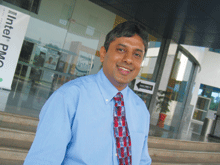Dilip Thakore interviewed Praveen Vishakantaiah, president of Intel Technologies India Pvt. Ltd, at the company’s state-of-the-art Intel Research Centre in Bangalore. Excerpts:
Intel India has been seriously engaged with Indian education for a decade. What is the corporate objective of this intervention?
 Intel Corporation is working towards enhancing the lives of people through technology in over 50 countries around the world, in which cause we spend around $100 million (Rs.450 crore) every year. In education our intent is to encourage the inclusion of revolutionary ICT (information communication technologies) into school classrooms to facilitate a transition into experiential or project-based learning — an approach that promotes higher order thinking and student centric learning. With this corporate objective in mind we are involved in K-12 school education as also in curriculum development and research in higher education. Moreover Intel India encourages entrepren-eurship promotion and supports incubation enterprises by providing technology mentoring. Our broad objective is to create awareness of, and comfort with, technology in the education sector.
Intel Corporation is working towards enhancing the lives of people through technology in over 50 countries around the world, in which cause we spend around $100 million (Rs.450 crore) every year. In education our intent is to encourage the inclusion of revolutionary ICT (information communication technologies) into school classrooms to facilitate a transition into experiential or project-based learning — an approach that promotes higher order thinking and student centric learning. With this corporate objective in mind we are involved in K-12 school education as also in curriculum development and research in higher education. Moreover Intel India encourages entrepren-eurship promotion and supports incubation enterprises by providing technology mentoring. Our broad objective is to create awareness of, and comfort with, technology in the education sector.
What is the extent and scale of Intel’s involvement with Indian education? What’s your annual investment in Indian education?
Under our Intel Teach program we train teachers to incorporate ICT in their classrooms. So far we have provided training to over 900,000 teachers across the country and we are all set to cross the 1,000,000 milestone next month (November). In addition we have also initiated the Intel Learn program for out-of-school and under-served children to familiarise them with ICT for use in their communities. To promote maths and science education in schools we have been running our IRIS (Initiative for Research and Innovation in Science) program for the past nine years under which we select the most innovative and inventive science and math secondary students in India for participation in the global Intel Science and Education Fair (ISEF) held annually in the US. For the past two years we have also been running a programme with the Union govern-ment’s Department of Science and Technology under which we fund research in higher education in select institutions through the provision of Intel scholarships. Thus our involve-ment with Indian education spans almost the entire education spectrum.
As for your query about the quantum of our expenditure in Indian education, Intel Corporation spends almost $100 million (Rs.450 crore) annually across 50 countries. In larger countries such as India and China it is significantly higher than the average per country because of the sheer size of education requirements.
The general impression is that Intel’s intervention in education is a purely CSR activity. Is this belief correct?
Your impression is correct. Intel’s interventions in education around the world — including India — are purely a CSR (corporate social responsibility) activity, although we often work in collaboration with companies which are in the business of education. Our objective is to grow the technology eco-system which we believe is in our long-term business interest. Therefore we liberally partner with government departments, NGOs and business enterprises.
How satisfied are you with the outcomes of Intel’s engagement with Indian education?
Very satisfied. We receive enthusiastic support from teachers, schools students, Indian academia and from government. In particular the cooperation and support we have received from the Department of Science and Technology, with whom we have initiated a joint program to improve teaching skills and research in engineering colleges and with whom we run the national DST-Intel Business Plan Contest to promote entrepreneurship in engineering, has been fantastic.
Commercially what are Intel India’s major businesses?
Intel’s major business is to design, manufacture and market micro-processors, which is the brain of every computer worldwide. The microprocessor, which becomes smaller, faster and more powerful every two years, has revolutionised business and industrial productivity. Intel Corporation has around 80 percent share of the global market for microprocessors.
Looking ahead, how optimistic are you about the future of Indian education which is in the doldrums?
I’m very optimistic about the future of Indian education as there is burning desire within the youth of the country to acquire knowledge and skills. Planning for education is becoming increasingly detailed, but the infirmity of our education system is in implementation. The way forward is to focus to a greater degree on teacher education and scale the number of well-trained, technology-enabled teachers. Indian education needs the public-private partnership model to be promoted in an aggressive manner. I believe that tripartite cooperation between government, academia and industry needs to be intensified to develop the country’s massive pool of high-potential human resources.